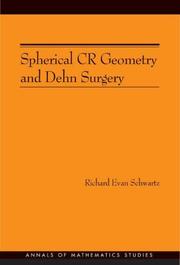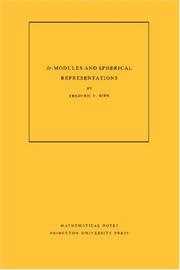| Listing 1 - 2 of 2 |
Sort by
|

ISBN: 069112809X 1400837197 0691128103 9780691128108 9781400837199 9780691128092 Year: 2007 Publisher: Princeton, NJ
Abstract | Keywords | Export | Availability | Bookmark
 Loading...
Loading...Choose an application
- Reference Manager
- EndNote
- RefWorks (Direct export to RefWorks)
This book proves an analogue of William Thurston's celebrated hyperbolic Dehn surgery theorem in the context of complex hyperbolic discrete groups, and then derives two main geometric consequences from it. The first is the construction of large numbers of closed real hyperbolic 3-manifolds which bound complex hyperbolic orbifolds--the only known examples of closed manifolds that simultaneously have these two kinds of geometric structures. The second is a complete understanding of the structure of complex hyperbolic reflection triangle groups in cases where the angle is small. In an accessible and straightforward manner, Richard Evan Schwartz also presents a large amount of useful information on complex hyperbolic geometry and discrete groups. Schwartz relies on elementary proofs and avoids "ations of preexisting technical material as much as possible. For this reason, this book will benefit graduate students seeking entry into this emerging area of research, as well as researchers in allied fields such as Kleinian groups and CR geometry.
CR submanifolds. --- Dehn surgery (Topology). --- Three-manifolds (Topology). --- CR submanifolds --- Dehn surgery (Topology) --- Three-manifolds (Topology) --- Mathematics --- Physical Sciences & Mathematics --- Geometry --- 3-manifolds (Topology) --- Manifolds, Three dimensional (Topology) --- Three-dimensional manifolds (Topology) --- Cauchy-Riemann submanifolds --- Submanifolds, CR --- Low-dimensional topology --- Topological manifolds --- Surgery (Topology) --- Manifolds (Mathematics) --- Arc (geometry). --- Automorphism. --- Ball (mathematics). --- Bijection. --- Bump function. --- CR manifold. --- Calculation. --- Canonical basis. --- Cartesian product. --- Clifford torus. --- Combinatorics. --- Compact space. --- Conjugacy class. --- Connected space. --- Contact geometry. --- Convex cone. --- Convex hull. --- Coprime integers. --- Coset. --- Covering space. --- Dehn surgery. --- Dense set. --- Diagram (category theory). --- Diameter. --- Diffeomorphism. --- Differential geometry of surfaces. --- Discrete group. --- Double coset. --- Eigenvalues and eigenvectors. --- Equation. --- Equivalence class. --- Equivalence relation. --- Euclidean distance. --- Four-dimensional space. --- Function (mathematics). --- Fundamental domain. --- Geometry and topology. --- Geometry. --- Harmonic function. --- Hexagonal tiling. --- Holonomy. --- Homeomorphism. --- Homology (mathematics). --- Homotopy. --- Horosphere. --- Hyperbolic 3-manifold. --- Hyperbolic Dehn surgery. --- Hyperbolic geometry. --- Hyperbolic manifold. --- Hyperbolic space. --- Hyperbolic triangle. --- Hypersurface. --- I0. --- Ideal triangle. --- Intermediate value theorem. --- Intersection (set theory). --- Isometry group. --- Isometry. --- Limit point. --- Limit set. --- Manifold. --- Mathematical induction. --- Metric space. --- Möbius transformation. --- Parameter. --- Parity (mathematics). --- Partial derivative. --- Partition of unity. --- Permutation. --- Polyhedron. --- Projection (linear algebra). --- Projectivization. --- Quotient space (topology). --- R-factor (crystallography). --- Real projective space. --- Right angle. --- Sard's theorem. --- Seifert fiber space. --- Set (mathematics). --- Siegel domain. --- Simply connected space. --- Solid torus. --- Special case. --- Sphere. --- Stereographic projection. --- Subgroup. --- Subsequence. --- Subset. --- Tangent space. --- Tangent vector. --- Tetrahedron. --- Theorem. --- Topology. --- Torus. --- Transversality (mathematics). --- Triangle group. --- Union (set theory). --- Unit disk. --- Unit sphere. --- Unit tangent bundle.

ISBN: 1400862078 9781400862078 0691025177 9780691608327 9780691025179 0691025177 0691608326 9780691608327 Year: 2014 Publisher: Princeton, NJ
Abstract | Keywords | Export | Availability | Bookmark
 Loading...
Loading...Choose an application
- Reference Manager
- EndNote
- RefWorks (Direct export to RefWorks)
The theory of D-modules deals with the algebraic aspects of differential equations. These are particularly interesting on homogeneous manifolds, since the infinitesimal action of a Lie algebra consists of differential operators. Hence, it is possible to attach geometric invariants, like the support and the characteristic variety, to representations of Lie groups. By considering D-modules on flag varieties, one obtains a simple classification of all irreducible admissible representations of reductive Lie groups. On the other hand, it is natural to study the representations realized by functions on pseudo-Riemannian symmetric spaces, i.e., spherical representations. The problem is then to describe the spherical representations among all irreducible ones, and to compute their multiplicities. This is the goal of this work, achieved fairly completely at least for the discrete series representations of reductive symmetric spaces. The book provides a general introduction to the theory of D-modules on flag varieties, and it describes spherical D-modules in terms of a cohomological formula. Using microlocalization of representations, the author derives a criterion for irreducibility. The relation between multiplicities and singularities is also discussed at length.Originally published in 1990.The Princeton Legacy Library uses the latest print-on-demand technology to again make available previously out-of-print books from the distinguished backlist of Princeton University Press. These editions preserve the original texts of these important books while presenting them in durable paperback and hardcover editions. The goal of the Princeton Legacy Library is to vastly increase access to the rich scholarly heritage found in the thousands of books published by Princeton University Press since its founding in 1905.
Differentiable manifolds. --- D-modules. --- Representations of groups. --- Lie groups. --- Groups, Lie --- Lie algebras --- Symmetric spaces --- Topological groups --- Group representation (Mathematics) --- Groups, Representation theory of --- Group theory --- Modules (Algebra) --- Differential manifolds --- Manifolds (Mathematics) --- Affine space. --- Algebraic cycle. --- Algebraic element. --- Analytic function. --- Annihilator (ring theory). --- Automorphism. --- Banach space. --- Base change. --- Big O notation. --- Bijection. --- Bilinear form. --- Borel subgroup. --- Cartan subalgebra. --- Cofibration. --- Cohomology. --- Commutative diagram. --- Commutative property. --- Commutator subgroup. --- Complexification (Lie group). --- Conjugacy class. --- Coproduct. --- Coset. --- Cotangent space. --- D-module. --- Derived category. --- Diagram (category theory). --- Differential operator. --- Dimension (vector space). --- Direct image functor. --- Discrete series representation. --- Disk (mathematics). --- Dot product. --- Double coset. --- Eigenfunction. --- Eigenvalues and eigenvectors. --- Endomorphism. --- Euler operator. --- Existential quantification. --- Fibration. --- Function space. --- Functor. --- G-module. --- Gelfand pair. --- Generic point. --- Hilbert space. --- Holomorphic function. --- Homomorphism. --- Hyperfunction. --- Ideal (ring theory). --- Infinitesimal character. --- Inner automorphism. --- Invertible sheaf. --- Irreducibility (mathematics). --- Irreducible representation. --- Levi decomposition. --- Lie algebra. --- Line bundle. --- Linear algebraic group. --- Linear space (geometry). --- Manifold. --- Maximal compact subgroup. --- Maximal torus. --- Metric space. --- Module (mathematics). --- Moment map. --- Morphism. --- Noetherian ring. --- Open set. --- Presheaf (category theory). --- Principal series representation. --- Projective line. --- Projective object. --- Projective space. --- Projective variety. --- Reductive group. --- Riemannian geometry. --- Riemann–Hilbert correspondence. --- Right inverse. --- Ring (mathematics). --- Root system. --- Satake diagram. --- Sheaf (mathematics). --- Sheaf of modules. --- Special case. --- Sphere. --- Square-integrable function. --- Sub"ient. --- Subalgebra. --- Subcategory. --- Subgroup. --- Summation. --- Surjective function. --- Symmetric space. --- Symplectic geometry. --- Tensor product. --- Theorem. --- Triangular matrix. --- Vector bundle. --- Volume form. --- Weyl group.
| Listing 1 - 2 of 2 |
Sort by
|

 Search
Search Feedback
Feedback About UniCat
About UniCat  Help
Help News
News